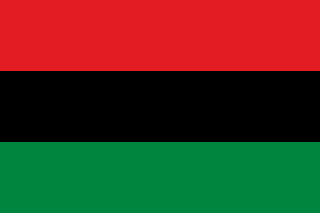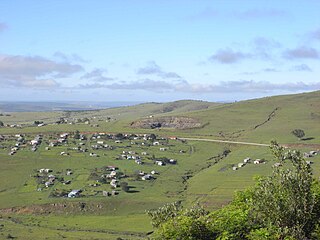Related Research Articles

Colonialism is the policy of a country seeking to extend or retain its authority over other people or territories, generally with the aim of economic dominance. In the process of colonisation, colonisers may impose their religion, economics, and other cultural practices on indigenous peoples. The foreign invaders/interlopers rule the territory in pursuit of their interests, seeking to benefit from the colonised region's people and resources.

Indigenous peoples, also known in some regions as First peoples, First Nations, Aboriginal peoples or Native peoples, or autochthonous peoples, are ethnic groups who are the original or earliest known inhabitants of an area, in contrast to groups that have settled, occupied or colonized the area more recently. Groups are usually described as indigenous when they maintain traditions or other aspects of an early culture that is associated with a given region. Not all indigenous peoples share this characteristic, as many have adopted substantial elements of a colonizing culture, such as dress, religion or language. Indigenous peoples may be settled in a given region (sedentary) or exhibit a nomadic lifestyle across a large territory, but they are generally historically associated with a specific territory on which they depend. Indigenous societies are found in every inhabited climate zone and continent of the world except Antarctica.
The African diaspora consists of the worldwide collection of communities descended from native sub-Saharan Africans or people from Sub-Saharan Africa, predominantly in the Americas. Historically, ethnographers, historians, politicians and writers have used the term particularly to refer to the descendants of the West and Central Africans who were enslaved and shipped to the Americas via the Atlantic slave trade between the 16th and 19th centuries, with their largest populations in Brazil, the United States and Haiti. Some scholars identify "four circulatory phases" of this migration out of Africa. Prior to the Atlantic slave trade, Arab traders took even more slaves from other parts of Africa, selling them to markets in North Africa and the Middle East.

The Fula,Fulani, or Fulɓe people are one of the largest ethnic groups in the Sahel and West Africa, widely dispersed across the region. Inhabiting many countries, they live mainly in West Africa and northern parts of Central Africa but also in South Sudan, Sudan, and regions near the Red Sea coast. The approximate number of Fula people is unknown due to clashing definitions regarding Fula ethnicity; various estimates put the figure between 25 and 40 million worldwide.
An ethnic group or ethnicity is a category of people who identify with each other, usually on the basis of presumed similarities such as common language, ancestry, history, society, culture, nation or social treatment within their residing area. Ethnicity is often used synonymously with the term nation, particularly in cases of ethnic nationalism, and is separate from but related to the concept of races.

Mestizo is a term historically used in Spain and Hispanic America that originally referred to a person of combined European and Indigenous American descent, regardless of where the person was born. The term was used as an ethnic/racial category for mixed-race castas that evolved during the Spanish Empire. Although broadly speaking, mestizo means someone of mixed European/indigenous heritage, the term did not have a fixed meaning in the colonial period. It was a formal label for individuals in official documentation, such as censuses, parish registers, Inquisition trials, and other matters. Individuals were labeled by priests and royal officials as mestizos, but the term was also used for self identification.

Afrocentrism is an approach to the study of world history that focuses on the history of people of recent African descent. It is in some respects a response to global (Eurocentric) attitudes about African people and their historical contributions; it seeks to correct what it sees as mistakes and ideas perpetuated by the racist philosophical underpinnings of western academic disciplines as they developed during and since Europe's Early Renaissance as justifying rationales for the enslavement of other peoples, in order to enable more accurate accounts of not only African but all people's contributions to world history. Afrocentricity deals primarily with self-determination and African agency and is a Pan-African point of view for the study of culture, philosophy, and history.
In sociology, a minority group refers to a category of people who experience relative disadvantage as compared to members of a dominant social group. Minority group membership is typically based on differences in observable characteristics or practices, such as: ethnicity, race, religion, sexual orientation, or disability. Utilizing the framework of intersectionality, it is important to recognize that an individual may simultaneously hold membership in multiple minority groups. Likewise, individuals may also be part of a minority group in regard to some characteristics, but part of a dominant group in regard to others.

The Swazi are a Bantu ethnic group of Southern Africa, predominantly inhabiting modern Eswatini, South Africa's Mpumalanga province and Mozambique. The Swazi are part of the Nguni family that can be archaeologically traced in East Africa where the same tradition, beliefs and cultural practices are found. The Swazi share a unique experience, culture and Royal lineage. This lineage is exclusive to the inhabitants of Eswatini, even though there have been more Swazi people that have moved to South Africa and the United Kingdom in the 20th century. The original inhabitants of Eswatini no longer reside in Eswatini as a majority population while some remain in the land. The Swazi people and the Kingdom of Eswatini today are named after Mswati II, who became king in 1839 after the death of his father King Sobhuza who strategically defeated the British who occupied Swaziland. The Kingdom of Swaziland was a region occupied by the San people of Southern Africa and the current Swazis came in from North Eastern regions through to Mozambique and eventually Swaziland in the 15th century. Mixtures with the San people and other Nguni tribes occurred. Their royal lineage can be traced to a chief named Dlamini I; this is still the royal clan name. About three-quarters of the clan groups are Nguni; the remainder are Sotho, Tsonga, others North East African and San descendants. These groups have intermarried freely. There are slight differences among Swazis as a nation with varying features and skin tones yet Swazi identity extends to all those with allegiance to the twin monarchs Ingwenyama "the Lion" and Indlovukati "the She-Elephant". The dominant Swati language and culture are factors that unify Swazis as a nation since there is no other language spoken except for English.
The Gullah are African Americans who live in the Lowcountry region of the U.S. states of Georgia, Florida, and South Carolina, in both the coastal plain and the Sea Islands. They developed a creole language, the Gullah language, and a culture rich in African influences that makes them distinctive among African Americans.
Dutch people or the Dutch are a Germanic ethnic group and nation native to the Netherlands. They share a common ancestry, culture and speak the Dutch language. Dutch people and their descendants are found in migrant communities worldwide, notably in Aruba, Suriname, Guyana, Curaçao, Argentina, Brazil, Canada, Australia, South Africa, New Zealand, and the United States. The Low Countries were situated around the border of France and the Holy Roman Empire, forming a part of their respective peripheries, and the various territories of which they consisted had become virtually autonomous by the 13th century. Under the Habsburgs, the Netherlands were organised into a single administrative unit, and in the 16th and 17th centuries the Northern Netherlands gained independence from Spain as the Dutch Republic. The high degree of urbanization characteristic of Dutch society was attained at a relatively early date. During the Republic the first series of large-scale Dutch migrations outside of Europe took place.

The culture in Africa is varied and manifold, consisting of a mixture of countries with various tribes that each have their own unique characteristic from the continent of Africa. It is a product of the diverse populations that today inhabit the continent of Africa and the African Diaspora. African culture is expressed in its arts and crafts, folklore and religion, clothing, cuisine, music and languages. Expressions of culture are abundant within Africa, with large amounts of cultural diversity being found not only across different countries but also within single countries. Even though African cultures are widely diverse, they are also, when closely studied, seen to have many similarities; for example, the morals they uphold, their love and respect for their culture as well as the strong respect they hold for the aged and the important, i.e. kings and chiefs.
Cultural appropriation, at times also phrased cultural misappropriation, is the adoption of elements of one culture by members of another culture. This can be controversial when members of a dominant culture appropriate from disadvantaged minority cultures.
White Americans are a racial or ethnic group of Americans who identify as and are perceived to be white people. The term is usually used to refer to those of European descent, though is at times also used to refer to Americans of North African and Middle Eastern descent. White Americans constitute the historical and current majority of the people living in the United States, with 72% of the population identifying as white in the 2010 United States Census. Non-Hispanic whites totaled about 197,181,177 or 61.1% of the U.S. population. European Americans are the largest ethnic group of White Americans and constitute the historical majority population of the United States since the nation's founding.

Aboriginal Australians are the various Indigenous peoples of the Australian mainland and many of its islands, such as Tasmania, Fraser Island, Hinchinbrook Island, the Tiwi Islands and Groote Eylandt, but excluding the Torres Strait Islands.

Namibian cuisine is the cuisine of Namibia. It is influenced by two primary cultural strands:
African-American dance has developed within Black American communities in everyday spaces, rather than in studios, schools or companies. These dances are usually centered on folk and social dance practice, though performance dance often supplies complementary aspects to this. Placing great value on improvisation, these dances are characterized by ongoing change and development. There are a number of notable African-American modern dance companies using African-American cultural dance as an inspiration, among these are the Whitey's Lindy Hoppers, Alvin Ailey American Dance Theater, Dance Theatre of Harlem, and Lula Washington Dance Theatre. Unlike European-American dance, African-American dance was not taxed in the fields of Europe where it began and has not been presented in theatrical productions by generations of kings, tzars, and states. Instead, it lost its best dancers to the draft and started requiring taxes from establishments in the form of a federal excise tax on dance halls enacted in 1944. Dance halls continue to be taxed throughout the country while dance studios are not, and African-American dance companies statistically receive less taxpayer money than European Americans. However, Hollywood and Broadway have provided opportunities for African-American artists to share their work and for the public to support them. Michael Jackson and Misty Copeland are among the most well-known African-American dancers.
Cultural practice is the manifestation of a culture or sub-culture, especially in regard to the traditional and customary practices of a particular ethnic or other cultural group.

The Xhosa nation are a Bantu ethnic group from Southern Africa whose homeland is primarily within the modern-day Eastern Cape. There is a small but significant Xhosa-speaking (Mfengu) community in Zimbabwe, and their language, isiXhosa, is recognised as a national language.
Black nationalism is a type of political thought that seeks to promote, develop and maintain a black race identity for people of black ancestry. Black nationalist activism revolves around social, political, and economic empowerment of black communities and people, especially to resist assimilation into white culture, and maintain a distinct black identity.
References
- ↑ Appiah, Kwame Anthony; Henry Louis Gates, Jr. (2010). Encyclopedia of Africa: Two-Volume Set. Oxford University Press. p. 496. ISBN 9780195337709.